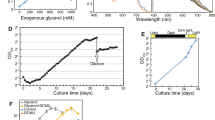Summary
Utilization of xanthine as the sole nitrogen source for growth byChlamydomonas reinhardtii cells involved the formation of a transient, intracellular pool of xanthine. Up to 20% of the total xanthine supplied to the medium was not assimilated after uptake but stored in the cells at concentrations that exceeded xanthine solubility in water. At the subcellular level, a massive accumulation of starch grains in the chloroplast and the appearance of many vacuoles in the cytoplasm distinguished xanthine-grown from ammonium-grown cells. Starch accumulation, but not development of vacuoles, was also observed in N-starved cells. Uptake experiments with radio-labelled xanthine showed that this accumulates only in the cytoplasm, most probably inside vacuoles. The electron-dense material observed in vacuoles of xanthine-grown cells suggests that the intracellular xanthine is in part solid xanthine.
Similar content being viewed by others
References
Alamillo JM, Cardenas J, Pineda M (1991) Purification and molecular properties of urate oxidase fromChlamydomonas reinhardtii. Biochim Biophys Acta 1076: 203–208
Alamillo JM, Cardenas J, Pineda M (1992) Kinetic and catalytic characterization of urate oxidase fromChlamydomonas reinhardtii. J Mol Catal 77: 353–364
Amman ECB, Lynch VH (1964) Purine metabolism by unicellular algae. II. Adenine, hypoxanthine and xanthine degradation byChlorella pyrenoidosa. Biochim Biophys Acta 87: 370–379
Antia NJ, Harrison PJ, Oliveira L (1991) The role of dissolved organic nitrogen in phytoplankton nutrition, cell biology and ecology. Phycologia 30: 1–89
Dagestad D, Lien T, Knutsen G (1981) Degradation and compartmentation of urea inChlamydomonas reinhardtii. Arch Microbiol 129: 261–264
Douglas AE (1983) Uric acid utilization inPlatymonas convolutae and symbioticConvolutae roscoffensis. J Mar Biol Assoc UK 63: 435–447
Gfeller RP, Gibbs M (1984) Fermentative metabolism ofChlamydomonas. Analysis of fermentative products from starch in dark and light. Plant Physiol 75: 212–218
González-Fernández A, Aller P, Sans J, De la Torre C (1992) Early and late replicating DNA involved in G1 to S transition inAllium cepa L. meristematic cells. Biol Cell 74: 243–247
Harris EH (1989) TheChlamydomonas sourcebook. A comprehensive guide to biology and laboratory use. Academic Press, San Diego
Krenitsky TA, Spector T, Hall WW (1986) Xanthine oxidase from human liver: purification and characterization. Arch Biochem Biophys 247: 108–119
Munch-Petersen A, Mygind B (1983) Transport of nucleic acid precursors. In: Munch-Petersen A (ed) Metabolism of nucleotides, nucleosides and nucleobases in microorganisms. Academic Press, London, pp 259–305
Oliveira L, Huynh H (1989) Ultrastructure and cytochemistry ofDunaliella tertiolecta Butcher andPavlova lutheri (Droop) Green grown on three different sources of organic nitrogen. New Phytol 113: 481–490
Pérez-Vicente R, Alamillo JM, Cárdenas J, Pineda M (1992) Purification and substrate inactivation of xanthine dehydrogenase fromChlamydomonas reinhardtii. Biochim Biophys Acta 1117: 159–166
—, Cardenas J, Pineda M (1991) Distinction between hypoxanthine and xanthine transport inChlamydomonas reinhardtii. Plant Physiol 95: 126–130
—, Pineda M, Cardenas J (1988) Isolation and characterization of xanthine dehydrogenase fromChlamydomonas reinhardtii. Physiol Plant 72: 101–107
Petersen R (1975) Control by ammonium of intercompartmental guanine transport inChlorella. Z Pflanzenphysiol 76: 213–223
Pineda M, Cabello P, Cardenas J (1987) Ammonium regulation of urate uptake inChlamydomonas reinhardtii. Planta 171: 496–500
—, Cardenas J (1985) The urate uptake system inChlamydomonas reinhardtii. Biochim Biophys Acta 820: 95–99
—, Fernández E, Cardenas J (1984) Urate oxidase ofChlamydomonas reinhardtii. Physiol Plant 62: 453–457
Reichert U, Winter M (1974) Uptake and accumulation of the purine bases by stationary yeast cells pretreated with glucose. Biochim Biophys Acta 356: 108–116
Roush AH (1961) Crystallization of purines in the vacuole ofCandida utilis. Nature 190: 44
—, Questiaux LM, Domnas AJ (1959) The active transport and metabolism of purines in the yeastCandida utilis. J Cell Comp Physiol 54: 275–286
Sueoka N (1960) Mitotic replication of deoxyribonucleic acid inChlamydomonas reinhardtii. Proc Natl Acad Sci USA 46: 83–91
Syrett PJ (1981) Nitrogen metabolism of microalgae. Physiological bases of phytoplankton ecology. Can J Fish Aquat Sci 210: 182–210
Author information
Authors and Affiliations
Rights and permissions
About this article
Cite this article
Pérez-Vicente, R., Burón, M.I., González-Reyes, J.A. et al. Xanthine accumulation and vacuolization inChlamydomonas reinhardtii cells. Protoplasma 186, 93–98 (1995). https://doi.org/10.1007/BF01276941
Received:
Accepted:
Issue Date:
DOI: https://doi.org/10.1007/BF01276941




